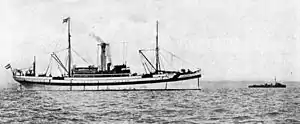 SS Ophelia | |
| History | |
|---|---|
| Name | Ophelia |
| Operator | Imperial German Navy |
| Route |
|
| Builder | Flensburger Schiffsbau Gesellschaft[1] |
| Launched | 16 January 1912 |
| Completed | 1912[1] |
| Fate | Captured 17 October 1914 |
| Name | Huntley |
| Fate | Torpedoed and sunk 21 December 1915[2] |
| General characteristics | |
| Tonnage | 1,153[1] |
The Ophelia was a steamship originally built by a German shipping company, but requisitioned for use as a hospital ship by the Imperial German Navy during the First World War. After being viewed acting suspiciously, the Ophelia was boarded on 17 October 1914 and seized by the Royal Navy for violating Hague Convention X of 1907 concerning hospital ships.
After her seizure, she operated in British service as SS Huntley until sunk in December 1915.
Seizure
On 17 October 1914 a number of German torpedo boats were destroyed during the Battle off Texel by the British cruiser, HMS Undaunted, while laying mines off Haak lightship.[3] German command sent out a hospital ship to supposedly search for survivors. Suspicions were aroused when British intelligence learned that Ophelia was using a wireless radio set,[4] at that time unusual for a hospital ship, to communicate with the German wireless base at Norddeich station. In addition to using wireless radio she was using coded wireless transmissions; secret codes or their use are forbidden on hospital ships.[4]
While in the area, British submarine, HMS D8, shadowed the German ship.[5] When the Ophelia noticed the sub she began to flee the area, further raising suspicions as her supposed task of searching for German survivors was not completed.[6] Under Article 4 of Hague Convention X, hospital ships cannot be seized but they can be inspected by enemy craft.
HMS Meteor was sent to investigate the ship.[2] As it approached for boarding and inspection it was observed that her commander, Dr. Pfeiffer, threw overboard a number of documents and secret codes.[3][7]
Reasons for seizure
The British Admiralty seized the Ophelia as a prize of war, rather than as a hospital ship. Their reasons for doubting her status as a hospital ship were the dumping of documents by the crew, the transmission of a coded message before the boarding, and the destruction of the ship's wireless set.[4][8] Furthermore, the ship was not included in the list of hospital ships that were exchanged at the start of the war.[9]
An enormous number of Verey lights were discovered on board. Fired from special pistols, Verey lights can be used as signal devices. The Ophelia had 600 green, 480 red and 140 white lights, and all records of how many she had before the seizure were destroyed before boarding. For comparison, a British hospital ship would stock about 12 lights of each colour.[6]
German response
Germany later used the seizure of the Ophelia to try and justify its attacks on hospital ships:
On 17 October, 1914 ... we sent out the hospital ship Ophelia to pick up any survivors. However, the English captured her and made her prize, charging us with having sent her for scouting purposes, although she was obviously fitted up as a hospital ship and bore all the requisite markings...We also considered ourselves released from our obligations and with far more justification took action against hospital ships which, under cover of the Red Cross flag, were patently used for the transport of troops. — German Admiral Scheer[10]
Aftermath
The British renamed the ship SS Huntley and used her for transporting fuel from Portishead to Boulogne. On 21 December 1915 she was torpedoed and sunk by German U-boat UB-10 .75 miles (1.21 km) off the Boulogne light vessel.[1][2]
See also
References
- 1 2 3 4 5 "Kirsten – The Fleets". The Ships List. 2009. Archived from the original on 10 October 2009. Retrieved 3 September 2009.
- 1 2 3 Helgason, Guðmundur. "Ships hit during WWI: Huntly". German and Austrian U-boats of World War I - Kaiserliche Marine - Uboat.net. Retrieved 3 September 2009.
- 1 2 "Hold German Hospital Ship" (PDF). The New York Times. 22 May 1915. Retrieved 2 September 2009.
- 1 2 3 Dieter Fleck, Michael Bothe (18 November 1999). The handbook of humanitarian law in armed conflicts (1999 ed.). Oxford University Press. p. 479; Clause: 1058. ISBN 0-19-829867-6. – Total pages: 589
- ↑ "HM Submarine D8". Roll-of-Honour.com. 21 March 2009. Retrieved 3 September 2009.
- 1 2 Frederick Edwin Smith Birkenhead. Famous Trials of History (2003 ed.). Kessinger Publishing. p. 273. ISBN 0-7661-6167-6. – Total pages: 316
- ↑ Thomas E Beam, Linette Sparacino. Military Medical Ethics, Volume 2 (when ed.). DIANE Publishing. p. 750. ISBN 1-4289-1066-2.
- ↑ "Convention (II) for the Amelioration of the Condition of Wounded, Sick and Shipwrecked Members of Armed Forces at Sea. Geneva, 12 August 1949". International Committee of the Red Cross. 2009. Retrieved 3 September 2009.
- ↑ "The Ophelia's status" (PDF). The New York Times. 6 November 1914. Retrieved 2 September 2009.
- ↑ Sir Andrew Macphail (28 February 2000). "Royal Canadian Naval Medical Service". Great War Primary Documents Archive. Retrieved 2 September 2009.